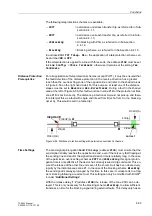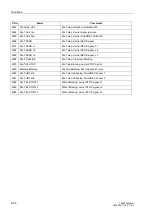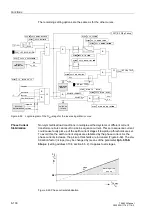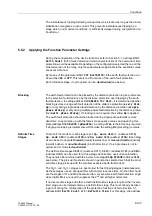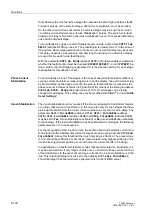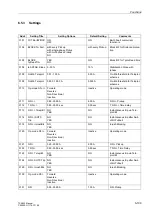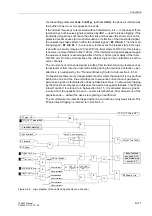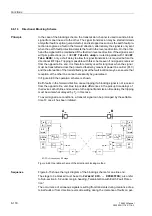
Functions
6-104
7SA522 Manual
C53000-G1176-C119-2
then determines the current pick-up threshold and address
the definite time delay.
The values for the time delay settings
(address
(address
(address
) are derived from the earth fault grading
coodination diagram of the system.
If the distance protection implements single-pole tripping, the earth fault protection
may be delayed by one grading margin to give preference to the phase selective trip-
ping by the distance protection over of the earth fault protection which always trips
three-pole. It is however also possible to block the earth fault protection with the dis-
tance protection (See “Blocking” above).
During the selection of the current and time settings, regard must be taken of whether
a stage should be direction dependent and whether it uses teleprotection. Refer to
also to the margin headings “Direction Determination” and “Teleprotection with Earth
Fault Protection”.
The set time delays are pure additional time delays which do not include the response
time (measuring time) of the protection.
Inverse Time Over-
current Stage with
IEC–Characteristic
Also for the inverse time overcurrent stage the operating mode must initially be set:
(address
). This stage can be set to operate
forward
(usually
towards line) or
reverse direction
(usually towards busbar) or
non-directional
(in
both directions). If a particular stage is not required, set its mode to
inactive
.
For the inverse time overcurrent stage 3I
0P
it is possible to select from a variety of
curves depending on the version of the relay and the configuration (Section 5.1, ad-
dress
) that was selected. If an inverse overcurrent stage is not required, the ad-
dress
is set to
(DUWK)DXOW2&
=
'HILQLWH7LPH
. The 3I
0P
–stage can
then be used as a fourth definite time stage (refer to “Definite Time Stages” above) or
deactivated. In the case of the IEC–curves (address
(DUWK)DXOW2&
=
72&
,(&
) the following alternatives are available in the address
,QYHUVH
(
normal inverse
, Type A according to IEC 60255–3),
9HU\LQYHUVH
(
very inverse
, Type B according to IEC 60255–3),
([WUHPHO\LQY
(
extremely inverse
, Type C according to IEC 60 255–3), and
/RQJ7LPH,QYHUVH
(
longtime
, Type B according to IEC 60255–3).
The curves and equations the curves are based on are illustrated in the technical data
(Section 10.9).
Similar considerations as for the definite time stages (see above) apply to the setting
of the pick-up threshold
(address
). In this case it must be con-
sidered that a safety margin has already been included between the pick-up threshold
and the setting value. The stage only picks up when the measured signal is approxi-
mately 10 % above the setting value.
The time multiplier setting
(address
) is derived from the
grading coordination chart which was set up for earth faults in the system.
In addition to the inverse current dependant time delay, a constant (fixed length) time
delay can also be set if this is required. The setting
(address
) is
added to the time of the set curve.
Inverse Time Over-
current Stage with
ANSI–Characteris-
tic
Also for the inverse time overcurrent stage the operating mode is initially set:
(address
). This stage can be set to operate
forward
(usually
towards line) or
reverse direction
(usually towards busbar) or
non-directional
(in
both directions). If a particular stage is not required, set its mode to
inactive
.
Summary of Contents for siprotec 7SA522
Page 20: ...7SA522 Manual C53000 G1176 C119 2 ...
Page 64: ...7SA522 Manual C53000 G1176 C119 2 ...
Page 89: ...SIPROTEC 4 Devices 4 25 7SA522 Manual C53000 G1176 C119 2 Figure 4 20 CFC Logic example ...
Page 408: ...7SA522 Manual C53000 G1176 C119 2 ...
Page 456: ...7SA522 Manual C53000 G1176 C119 2 ...
Page 516: ...7SA522 Manual C53000 G1176 C119 2 ...
Page 620: ...Appendix B 48 ...




